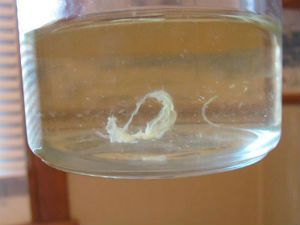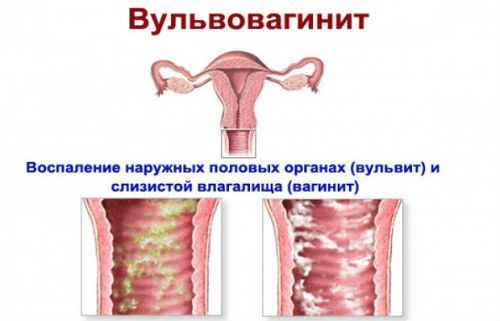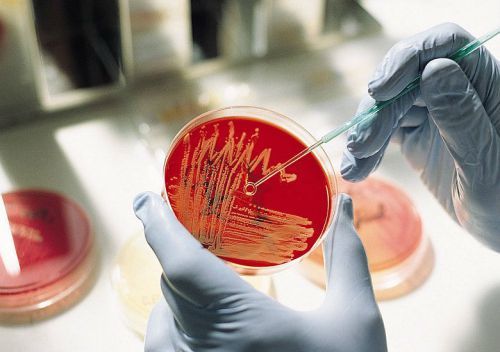Change the color of urine and appearance in it of any impurities, should not be ignored, because it can be a manifestation of various pathological processes in organs of genitourinary system and beyond.
Urine is the end product of the metabolic processes occurring every second in the human body. Thanks urinary sediment is the removal of toxic substances and toxins, which are filtered in the kidneys from the blood serum.
Normal urine of a healthy person is absolutely transparent and has a light straw color (the shade varies from light yellow to deep yellow). The color intensity can influence physiological factors such as the nature of food intake, volume of fluid intake, level of physical activity and others.
If appear in the urine, the clots white, or urinary sediment becomes cloudy and takes on a different hue (e.g., pink or bright red), you need to seek the help of a specialist who will diagnose and prescribe the appropriate treatment.

Physiological causes of urine white clots
Not always white strands in urine or clots are an indicator of the onset of the disease, because there are factors that can lead to their appearance.
These include:
- Failure to observe the rules of personal hygiene when collecting analysis. It is more common for women because their genitals are in close contact with the urethra. In a container for urine, possible contact with secretions from the lumen of the vagina, and cell Kumanovo epithelium. Therefore, it is important to treat genitals before testing, and used to study average portion of urine.
- The use of non-sterile containers (e.g., jars of food, baby purees, juices, etc.). This obviously can cause various impurities in the urinary sediment. Must be purchased at the pharmacy special sterile containers to the laboratory results were as accurate as possible.
- Eating large amounts of protein foods, which does not become completely assimilated by the human body. In urine appear white flakes, fibers or clumps, which are quite often diagnosed in vegetarians.
- Long-term fasting, elimination from the diet of carbohydrates and foods containing fat (different variants of strict diets). This leads to the fact that the human body goes on the cleavage of its own proteins and this can result in a serious malfunction, and most biochemical processes.

If the urine is collected without preliminary preparation, it is possible not only for the emergence of different inclusions, but clear clouding of urine
The list continues:
- alcohol abuse before the study, increasing the stress on the glomerular apparatus of the kidneys, and leads to the appearance in the urinary sediment of different impurities;
- the low level of water stress, especially if the human body is daily exposed to severe physical stress or intense sports activities;
- incorrect or prolonged storage of urine at home or a late diagnosis in the laboratory (the formation of natural sediment) – quite often patients are trying to freeze the urine or a certain time keep it in the fridge, which is a gross mistake (the collected urine, it is necessary to investigate not later than 1.5-2 hours from the moment of receipt);
- prior prolonged fever (for example, SARS or other infectious process);
- administration of various medications (must read the instructions carefully to make sure that the white clumps of urine are the possible adverse effect of the therapy).

Another reason is pregnancy. It pregnant women quite often report the emergence of pathological impurities (mucus, flakes, white clots, etc.) that float in the urine. In the period of gestation increases the production of vaginal mucus, which leads to abundant secretions of different nature. They are able to get in the urine at the time of collection.
In this case, the woman is recommended to re-testing in compliance with all rules of hygiene, including the use of a tampon.
Men white clots in the urinary sediment may be traces of semen (sperm). Also the sperm in the urine can occur in women leading sexual life without contraception if a few hours before the studies were preceded by a sexual act.
Before you give a pregnant woman a referral for a urine test, the doctor is obliged to explain in detail to her how you need to prepare for this
Pathological causes
The white blobs are represented by different cellular elements (protein, leukocytes, epithelium, bacteria, cylinders, etc.), their appearance may be due to the beginning of the following diseases:
- Inflammation of the tissues and structures of the kidneys (acute and chronic forms of pyelonephritis or glomerulonephritis), and other pathological processes (e.g., amyloidosis or renal tuberculosis).
- Clots in the urine in these diseases presents with pus (in case of pyelonephritis and renal tuberculosis) or protein casts (if we are talking about glomerulonephritis or amyloidosis).
- Inflammation of the tissues of the bladder (acute or chronic cystitis). Pathognomonic for the disease is purulent urine due to its content of large number of leukocytes (pyuria).
- Inflammation of the urethra (acute or chronic urethritis). A special role belongs to infectious processes of origin of sexually transmitted (STIs) such as gonorrhea, trichomoniasis, etc. Enable in the urine of patients is quite abundant, they are represented by clumps of fibers or flakes.
- Inflammation of the prostate gland (acute and chronic prostatitis). At the beginning of the disease the urine of patients, as a rule, contains only epithelial cells and mucus from the lumen of the urethra. Gradually it appears many white blood cells, and mucous component becomes milky, due to which urine becomes white in color (typical for chronic forms of prostatitis).
- Tissue inflammation of the glans penis and foreskin (acute and chronic balanoposthitis). In the first portion of the urine of such patients contains many white blood cells, which gives it a muddy color.
- Urolithiasis. The appearance of white clumps in urine may be due to stones phosphate origin, which have a grayish-white color. In self-discharge of stones of small size, they are getting in the urinary sediment that can be identified with the naked eye.
Purulent inclusions on the background of urolithiasis indicates the beginning of the inflammatory process in the urinary tract (eg, cystitis or urethritis).

Bacterial vaginosis, candidiasis, vulvovaginitis, endometritis, oophoritis, and other inflammatory processes in the organs of the reproductive system in women can cause white clots. In these diseases of the genital tract are unpleasant and profuse discharge of different character (mucous, Muco-purulent, cheesy, etc.). These allocations are severely disturbed woman, as cause severe itching and discomfort.
Often the spread of infectious process in the urethra and the overlying departments
Pathological symptoms which you need to pay attention
As a rule, the appearance of white clumps in urine is not the only symptom of the disease, and may be accompanied by the following complaints:
- the emergence of unpleasant or painful sensations associated with urination(cramps, burning, discomfort);
- frequent urge to emptying of the bladder, which may be imperative in nature, which forces the patient to constantly stay close to a toilet;
- the onset of sudden pain, which becomes painful and deprives the patient of any rest and sleep (we are talking about renal colic);
- patients complain of pain in the lower abdomen that may radiate to the perineum, rectum or thighs;
- from the lumen of the vagina or urethra appear persistent allocation, bringing a strong sense of discomfort and accompanied by intolerable itching;
- the increase in body temperature, the presence of intoxication syndrome (weakness, lethargy, reduced work capacity, sleepiness, etc.) and other manifestations.

Pyelonephritis in the lumbar region on one or both sides there is pain of varying intensity (nagging, aching, etc.)
Diagnostic methods
Collecting medical history, the doctor explains in detail all complaints and the time of their occurrence, the factors that could precede, etc.

Laboratory-instrumental examination includes the following methods:
- General clinical analysis of blood and urine tests (to assess the inflammatory component and its severity, as well as other cellular changes); biochemical analysis of blood (determine metrics such as total protein and protein fractions, creatinine, urea, fibrinogen, etc.);
- urine analysis according to Nechyporenko (according to indications);
- seeding of the urinary sediment on nutrient media, and determination of antibiotic sensitivity have discovered infectious agents;
- bacterial study of secretions of the vagina and the urethra (if any);
- General x-ray of the urinary tract and excretory urography;
- Ultrasound of the genitourinary system (the method used to detect inflammatory changes, the presence of stones, mass lesions, etc.);
- CT and MRI (the methods with the highest informativeness and diagnostic value, are indispensable in complex clinical cases).
The farming culture of the pathogen is an important and mandatory step in diagnosis
Treatment
Treatment of patients starts only after doctor will establish the exact cause of the appearance in the urine white clots, that is, any therapy should wear etiological orientation. When talking about the physiological causes of this symptom, the important role played by the correction of nutritional guidelines and lifestyle.
Patients recommended full to eat (the food should be balanced and enough vitamin), keep sufficient water pressure, not to neglect the intimate hygiene, etc.
For the treatment of all infectious processes of bacterial origin (cystitis, pyelonephritis, urethritis, prostatitis, etc.) primarily used antibacterial agents with broad spectrum (penicillins, cephalosporins of 3-4 generations, and others). They are appointed in a therapeutic dosage, the choice of which depends on the underlying disease and its severity.
If it is fungal or viral processes, the main place in therapy of patients will belong to the drugs of the respective groups (antiviral and antifungal agents).
Also apply the following groups of medicines:
- diuretics;
- painkillers and antispasmodics;
- anti-inflammatory and antihistamines;
- phytotherapy (use of medicinal products that contains only natural ingredients), etc.
The appearance of white clumps in urine is not always a sign of a pathological process in the body, so do not succumb to premature panic, but should be timely seek medical advice. The same applies to patients who do not see this as a symptom of a problem, and not rush for help to a specialist, as their General health remains satisfactory.
Remember that early diagnosis of any disease will not only get rid of the disease, but also significantly reduce the risk of possible complications.




I get the feeling that you may be trying to be uncontroversial with your post, but please understand that the polarized musings sometimes lead to healthy debate when approached with respect..and it IS your blog not a democracy- allow your voice be King here!